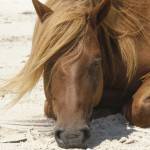Equine Motor Neuron Disease

Equine motor neuron disease (EMND) is characterized by the rapid onset of trembling, constant shifting of weight in the rear legs, frequent lying down, and muscle wasting. About 40% of affected horses are so severely impaired that they are euthanized within four weeks of the time signs of disease are first noticed. Another 40% begin to improve after about four to six weeks of treatment, and the remaining 20% survive but have significant permanent muscle atrophy. Analysis of data collected for horses diagnosed with EMND showed that affected horses had usually been at the same location for at least 18 months; had little or no time at pasture; and were fed grass hay.
In a trial designed to collect information about the cause of EMND, four horses were fed an experimental diet with low vitamin E and high levels of iron and copper. Three additional horses were fed a diet with low vitamin E and normal levels of iron and copper. All these horses had access to hay but were not given access to pasture. Beginning at about 22 months after the start of the study, all the horses with diets low in vitamin E developed EMND.
Two groups of control horses ate the same diets but were allowed access to fresh grass, an excellent natural source of vitamin E. Among these horses, there were no cases of EMND.
Horses with access to pasture usually have adequate muscle stores of vitamin E. Horses removed from pasture tend to deplete the stored vitamin E after about 18 months, and unsupplemented animals may develop deficiency signs after this length of time. It is recommended that all horses without access to green forage be supplemented with vitamin E to prevent EMND and other neurological conditions.








